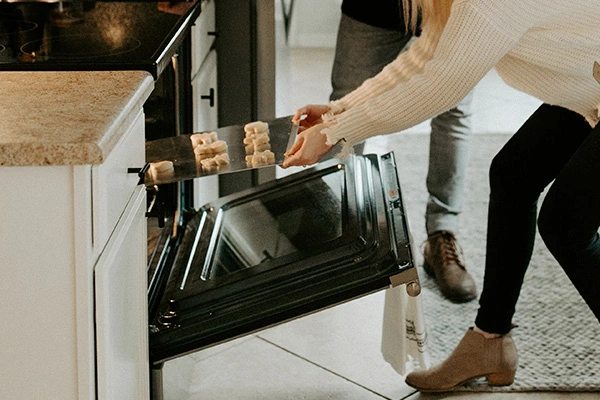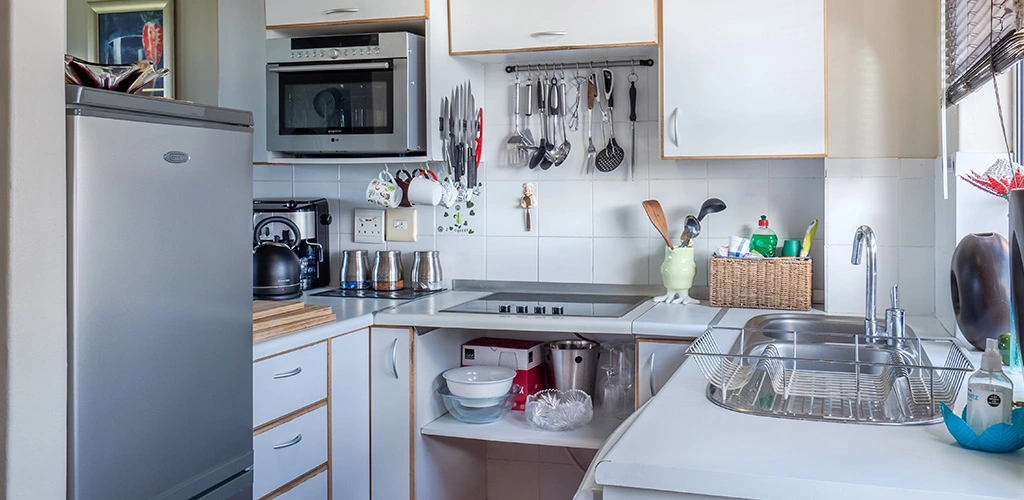In this world, household appliances effortlessly integrate into our daily life. This household’s unsung heroes include the refrigerator’s hum and the washing machine’s calming hum. But in the hurry and bustle, we often neglect these gadgets’ maintenance. In this blog, we delve into the crucial question: How do we maintain home appliances at home? Come learn easy yet efficient ways to prolong and optimize your cherished house companions. Give your appliances the power they need to last.
Home appliances are essential to our daily life, with 80% of American families owning a refrigerator, 69% a clothes washer and dryer, and over 52% a dishwasher, 81% microwave oven and traditional oven.
Proper maintenance keeps these appliances running smoothly, lasts longer, and prevents malfunctions. Maintaining appliances also ensures they don’t release harmful gases or pose other risks.
Table of Contents
How do we maintain home appliances at home?
We often neglect appliance maintenance due to our hectic schedules. Following these simple standards makes cleaning and maintaining appliances easy. Replace air filters, clean spills, examine parts and components, replace old items, ensure proper installation, and more. With proper maintenance, your appliances can make your home feel like home for years.
Refrigerator Maintenance

The first home appliance on our list is a refrigerator. When it comes to how do we maintain home appliances at home, let’s check the maintenance activities one by one. Maintenance is necessary because refrigerators work hard to keep food fresh and avoid deterioration. Cleaning the fridge’s condenser coils on the back is important. Dust and dust on refrigerator coils make it work harder to remove heat. Remove trash from coils monthly with a vacuum or coil cleaning brush.
Water filters should be replaced every six months to keep the fridge running smoothly. Fridge water filters remove pollutants from water and ice. Filters clog with time, limiting flow and water quality. See the user handbook for filter location and replacement.
A manual defrost fridge’s freezer should be defrosted occasionally to extend its lifespan. More than 1/4 inch of frost in the freezer compartment reduces cooling efficiency. Stop the fridge, remove frozen foods, and put towels in the freezer to capture melted frost to defrost. Scrub frost using a spatula without puncturing the freezer walls.
Coil cleaning, filter replacement, and defrosting boost refrigerator energy efficiency, food safety, and longevity. Perishable food refrigerators work best with regular maintenance.
Dishwasher Maintenance
The dishwasher is our second home appliance on our list. When we discuss how do we maintain home appliances at home, we have provided the instructions in an organized way. Regular dishwasher maintenance keeps dishes and glasses clean.

Tips for dishwasher maintenance:
- Clean the food trap or filter: Clean the food trap or filter to prevent food particles from recontaminating clean dishes. Filter removal and cleaning every couple weeks. Your owner’s manual will explain how to remove and clean the filter.
- Add rinse aid regularly: Regularly add rinse aid to avoid dish stains and film. Monthly check and refill the rinse aid dispenser. Use a dishwasher-specific rinse aid.
- Run cleaning cycles: Many dishwashers offer an internal cleaning cycle. Check your owner’s manual for cleaning cycle instructions. Monthly or as needed cleanings maintain the interior fresh and avoid smells. For grease and limescale removal, run the cycle with dishwasher cleaning or vinegar.
Maintenance keeps your dishwasher running smoothly and your dishes clean. Please see the owner’s manual for additional maintenance. Maintaining your dishwasher extends its life.
Washing Machine Maintenance
The third appliance is a washing machine. Let’s discuss How do we maintain home appliances at home. Regular maintenance keeps washing machines working smoothly and prevents problems. Cleaning the lint trap is crucial to washing machine maintenance. Lint can quickly clog the trap. We recommend cleaning the lint trap after each load. Open the trap door and remove the lint.
Remember to leave the washing machine door open after cycles to dry the inside. Shutting the door when it’s damp might cause mold, mildew, and odors. Allow thorough air drying between loads.
Monthly cleaning prevents residue buildup and freshens the washer. Clean your washer or run an empty hot water cycle with vinegar or baking soda. Heat and acid dissolve soap scum and hard water.
Cleaning the lint trap, leaving the door open, and performing cleaning cycles will keep a washing machine functioning smoothly and prevent problems. Making time for regular maintenance extends the life of washing machines.

Dryer Maintenance
Talking about dryer maintenance. Let’s see How do we maintain home appliances at home. Proper dryer maintenance keeps clothing dry effectively and safely. Lint trap cleaning is crucial dryer maintenance. Lint builds up quickly and should be removed after each load. A clogged lint trap reduces airflow and slows drying. Use your hand to remove lint from the trap instead of throwing it away. Additionally, clean the trap housing with lint.
The dryer’s vent pipe should also be checked regularly. Detach the hose and inspect for lint or clogs. Scrub garbage with a vent brush. Make sure the external vent flap opens freely and the vent hose is clear throughout.
Wipe the drying drum inside occasionally to remove residue. Wet a cloth with mild soap and wipe the drum clean. Do not use abrasive cleansers or scouring pads on drums. Run a short drying cycle after wiping the drum to eliminate moisture.
Cleaning the lint trap, vent hose, and drum will keep your dryer running safely and efficiently for years. Consult your owner’s manual for further maintenance tips. Proper dryer care speeds up drying and prevents fires.
Oven Maintenance
Cleaning and maintaining your oven improves food hygiene and appliance longevity. To increase the lifespan of the oven, we need to know how do we maintain home appliances at home.
Oven cleaning and maintenance tips:
Clean the Oven Racks and Trays
- Remove oven racks and trays and wash them in warm soapy water every two months. Grease and food residue are removed. Scrub using a brush or sponge.
- Spray racks and trays with white vinegar for severe baked-on stains and food. After soaking for 15-20 minutes, scrub with a brush or steel wool. Vinegar loosens dirt.
- Scrubbing pads can harm racks and trays.
Remove Burned on Food in the Oven
- Scrub stubborn oven spots with baking soda paste. Mix 3 parts baking soda with 1 part water and apply to stains. Wait several hours before scrubbing. Baking soda gently abrades.
- Spray oven cleaning on stubborn food and grease. Apply as directed, wait, and scrub clean. Utilize kitchen ventilation while using powerful chemical oven cleansers.
- Run the self-cleaning cycle if your oven has one. Food residue is burned with intense heat. Start by removing racks and trays and ventilating your kitchen.
Check the Oven Door Gaskets
- Check the oven door rubber seal every several months. Check for chips, tears, and wear.
- Replace worn gaskets. Worn gaskets let heat escape, reducing oven efficiency.
- Remove oil and food from the door gasket with warm soapy water. Grime can impede door sealing.
These oven cleaning and maintenance methods can keep your oven operating and hygienic for cooking.
Microwave Maintenance

Regular maintenance keeps your microwave functioning smoothly and extends its lifespan. How do we maintain home appliances at home? Here are the microwave maintenance tips:
- Clean inside regularly. Clean the walls and turntable with a moist cloth and mild detergent. Make a mixture of baking soda and water for difficult grease stains and scrub gently before wiping clean. Clean up food spills immediately.
- Clean the exterior as needed. Clean the door, handle, and control panel with a gentle cloth. Outside, avoid aggressive cleansers and abrasives that might damage the finish.
- Check the door alignment. The microwave door should close straight and seal correctly. Alternatively, correct the door alignment or replace the seal.
- Check heating. Heat 1 cup of water in a microwave-safe container for 1 minute at high power. Boil or use very hot water. If not, the magnetron may need repair.
- Replace charcoal filter. For odor-trapping, microwave vent fan charcoal filters should be replaced every 6–12 months. Consult your owner’s handbook for replacement intervals.
- Call a technician for power, display, or significant damage concerns you can’t fix. DIY microwave maintenance is not advised.
Regular microwave maintenance keeps it functioning properly for years. Use these techniques to maximize your kitchen’s microwave oven lifespan.
Vacuum Maintenance
Regular maintenance keeps vacuums running well. Understand how do we maintain home appliances at home? Let’s discuss some vacuum maintenance tips:
- Check and clean filters: Check and clean or replace vacuum filters every few usage. It keeps dust particles out of the motor. Check your owner’s manual for filter access and cleaning.
- Check belts: Belt-driven vacuums should be monitored for wear and replaced as needed. Stretched or fractured belts reduce suction.
- Change the bags regularly: For bagged vacuums, change the bag when it hits the “full” line. Overstuffed bags reduce suction and harm vacuums. See if the bag needs changing.
- Inspect attachments: Check hoses, wands, and brushes for obstructions. Debris cleanup as needed.
- Check for clogs: Check for obstructions in the hose, wand, and air ducts if you lose suction.
- Replace filters and belts: Replace belts and filters: Standard filters need replacing every 3–6 months. Replace belts every 12–24 months or as advised. Quality replacement parts can extend the vacuum’s life.
Maintenance keeps your vacuum running efficiently for improved floor cleaning and extends its life. For model-specific schedules and methods, consult manufacturer directions.
Small Appliances
Toasters, mixers, and blenders are essential food preparation tools that need minimal maintenance. How do we maintain home appliances at home? Tips for maintaining these essential kitchen tools:
- Toasters: Empty the crumb tray often. Brushes or pressurized air can remove crumbs from crevices. Wipe the exterior with a wet cloth. Toaster should not be submerged.
- Blenders and Mixers: Clean mixer heads and beaters with a toothbrush regularly. Ensure the gaskets are unbroken. After each use, remove and clean the blender blade assemblies. Every two weeks, disinfect blades and removable parts.
- Proper Storage: Make sure small appliances are unplugged before storing. Place them in a dry, clean cabinet or pantry. Upright storage reduces oil and grease buildup. Cool appliances before storing.
- Other Tips: Cleaning instructions are in the manual. Assess part wear and replace it as needed. Avoid drying food residue on appliances. Occasionally soak appliance parts in hot, soapy water for deeper cleaning.
Regular cleaning and storage will keep small kitchen appliances working effectively for years.
Conclusion
Maintaining home equipment routinely ensures its efficiency and longevity. Key maintenance advice from this article:
- Clean your dryer’s lint trap after each load. This prevents fire-causing accumulation.
- Explain how to clean refrigerator coils and condensers for efficiency.
- Clean the dishwasher monthly with vinegar to keep it fresh.
- Remove residue periodically with a freshener or other washing machine cleaning.
- Prevent messes by cleaning the microwave vent and turntable periodically.
- For best suction, replace vacuum filters and bags when full.
- Care for tiny items like coffee makers by following the handbook.
The benefits of appliance maintenance:
- Efficiency reduces energy bills and extends appliance life.
- Avoids costly appliance repairs and replacements.
- Makes appliances work like new.
- Early detection of fridge leaks improves safety.
- Rest easy knowing your appliances are well-maintained.
Follow the maintenance instructions to keep your household appliances functioning properly for years. Long-term care saves money and trouble.
